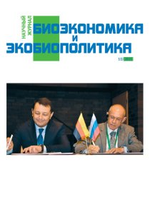Study of Functional Efficasy of Seven-Transmembrane Receptors throught the Molecular Simulation and Structural Bioinformatics
Авторы: Новиков Г. В., Сивожелезов В. С., Богдан Т. В., Алексеев Е. С., Golebiowski Jerome
Рубрика: Тезисы
Опубликовано в Биоэкономика и экобиополитика №1 (1) декабрь 2015 г.
Дата публикации: 30.01.2016
Статья просмотрена: 2 раза
Библиографическое описание:
Study of Functional Efficasy of Seven-Transmembrane Receptors throught the Molecular Simulation and Structural Bioinformatics / Г. В. Новиков, В. С. Сивожелезов, Т. В. Богдан [и др.]. — Текст : непосредственный // Биоэкономика и экобиополитика. — 2015. — № 1 (1). — URL: https://moluch.ru/th/7/archive/20/694/ (дата обращения: 25.04.2025).
Seven-transmembrane receptors belong to a large class of signaling proteins involved in cellular responses to a variety of extracellular signals, such as hormones and neurotransmitters, odors and pheromones. According to the “functional selectivity” concept receptor’s conformational dynamic is thermal-driven engine which govern transitions between its functional-relevant substates associated with specified signal transduction pathways. Within this paradigm any external factors such as binding of ligands or introduction of point mutations within receptor's amino acid sequence act as the modulators of its dynamical equilibrium resulting in shifting of receptor's molecular efficacies. In scope of this study receptor’s functional efficacy has been envisioned from the point of view of statistical thermodynamic laws based on the protein ensemble theory. Using methods of molecular dynamics simulation restrained by experimental data it was possible to compare receptor’s conformational flexibility observed in molecular dynamics simulation with the distribution of its X-ray structures. This combination of molecular modeling and structural bioinformatics produced results which were in good agreement with the well-known models describing receptor's functional behavior. It was found that binding of full agonists shifted receptors dynamical equilibrium towards its active sub-state which was structurally resembled its active conformation trapped using X-ray crystallography. In contrast, binding of inverse agonists, resulted in stabilization of the receptor in the inactive conformation, greatly reducing the overall degree of its conformational flexibility. The same dynamical patterns were also observed as the result of molecular modeling and simulations with introduction of point mutations within the sequence of the ligand-free-receptor. Eventually it was concluded that receptor's constitute (ligand-independent) activity directly associated with its conformational dynamics within different external factors act as the modulators which alter receptor's pre-existing equilibrium. Our results are in good agreement with modern experimental data providing structural insights on the activation of G-protein coupled receptors from the point of view of its structural dynamics.







